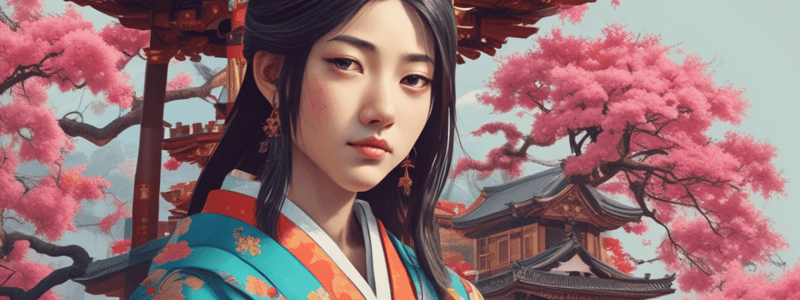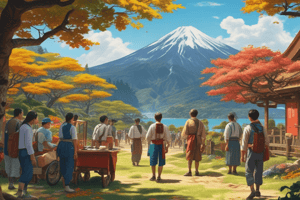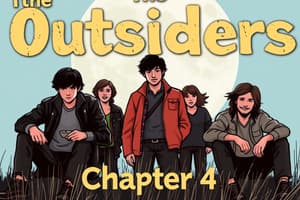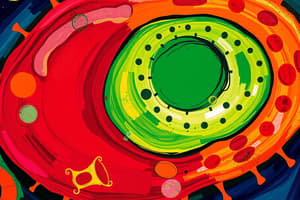Podcast
Questions and Answers
How did Queen Mary I's reign impact the religious landscape of England?
How did Queen Mary I's reign impact the religious landscape of England?
- She solidified Protestantism as the dominant religion
- She attempted to restore Catholicism, earning the nickname 'Bloody Mary' (correct)
- She embraced religious tolerance and allowed both Catholics and Protestants to practice freely
- She established a new branch of Christianity, distinct from Catholicism and Protestantism
What was the primary reason behind the threat posed by the Spanish Armada during Elizabeth I's reign?
What was the primary reason behind the threat posed by the Spanish Armada during Elizabeth I's reign?
- Philip II of Spain wanted to conquer England and restore Catholicism (correct)
- Spain sought to establish trade routes with England's colonies
- Philip II wanted to marry Elizabeth I and unite the two kingdoms
- Spain aimed to prevent the spread of Protestantism in Europe
What was the significance of Elizabeth I's religious settlement?
What was the significance of Elizabeth I's religious settlement?
- It created a moderate form of Protestantism, incorporating some Catholic rituals (correct)
- It granted equal rights to Catholics and Protestants in England
- It abolished the Catholic Church in England entirely
- It established Anglicanism as the official religion of England
What was the significance of Henry VIII's marriage to Jane Seymour?
What was the significance of Henry VIII's marriage to Jane Seymour?
How did Elizabeth I's gender impact her reign as monarch?
How did Elizabeth I's gender impact her reign as monarch?
What was the significance of Elizabeth I being known as the 'Virgin Queen'?
What was the significance of Elizabeth I being known as the 'Virgin Queen'?
What was the primary factor that led to the formation of the Church of England?
What was the primary factor that led to the formation of the Church of England?
Why did Henry VIII want to divorce Catherine of Aragon?
Why did Henry VIII want to divorce Catherine of Aragon?
What was the primary reason for Sir Thomas More's execution?
What was the primary reason for Sir Thomas More's execution?
Which queen tried to bring back Catholicism to England?
Which queen tried to bring back Catholicism to England?
What was the outcome of Henry VIII's marriage to Jane Seymour?
What was the outcome of Henry VIII's marriage to Jane Seymour?
Why was Anne Boleyn accused of treason and beheaded in 1536?
Why was Anne Boleyn accused of treason and beheaded in 1536?
Who wanted to invade England, dethrone Elizabeth I, and re-establish Catholicism?
Who wanted to invade England, dethrone Elizabeth I, and re-establish Catholicism?
What title is given to Elizabeth I due to her decision not to marry or share power?
What title is given to Elizabeth I due to her decision not to marry or share power?
Why did Mary Queen of Scots face execution during Elizabeth I's reign?
Why did Mary Queen of Scots face execution during Elizabeth I's reign?
What significant change did Elizabeth I make regarding the use of Latin in sermons?
What significant change did Elizabeth I make regarding the use of Latin in sermons?
Who opposed Henry VIII's Act of Supremacy and faced execution as a consequence?
Who opposed Henry VIII's Act of Supremacy and faced execution as a consequence?
Flashcards are hidden until you start studying
Study Notes
Isolation of Japan
- Causes of Isolation:
- Fear of European ideas
- Fear of losing Japanese traditions
- Missionaries of Christianity (mostly Catholic)
- Period of Warring States (1467-1568)
- Oda Nobunaga seized control of feudal estates and introduced firearms
- Tokugawa Ieyasu unified Japan in 1600 and became shogun in 1603
- Changed Japan's capital name from Edo to Tokyo
- Tamed daimyo by holding their families hostage and centralized power
- 1616-1867 Tokugawa Shogunate Rule:
- Structured society (patriarchal)
- Created stability after centuries of war and chaos
- Peasants suffered and paid high taxes, while merchants and rich thrived
- Emperor was figurehead, Shogun was true ruler
- Social hierarchy:
- Land-holding Samurai (daimyo)
- Samurai warriors
- Peasants and artisans (4/5ths of population)
- Merchants
- Cultural influences:
- Arrival of Buddhism in Japan (~6th century)
- Confucianism
- Ceremonial Noh dramas
- Kabuki (elaborate costumes, music, dance, mime)
- Haiku (5-7-5 poem)
- European influences:
- Portuguese traders arrived in 1500s
- Guns and cannons introduced to Japanese
- Japanese rejected European ideas and values
- Rebellion and persecution:
- 1637: 30,000 peasants rose up in rebellion
- Tokugawa Shogunate believed Christianity was the cause
- Christianity banned, Christians persecuted and driven out
- All Japanese forced to demonstrate faithfulness to Buddhism
- 1639: "Closed country policy" for over 200 years
Exploration of the Americas
- Christopher Columbus (1492):
- Funded by Spain (Queen Isabella and Prince Ferdinand)
- Italian from Genoa
- Thought he found India or East Indies
- Consequences:
- 90% of indigenous people wiped out by disease
- Many treated indigenous people horribly (murdering, enslaving, colonizing)
Other Explorers
- Pedro Álvares Cabral (1500):
- Sent by Portugal to Brazil
- Found little gold or silver, built large sugar plantations
- Amerigo Vespucci (Italian):
- Believed lands were a New World, a new continent
- German mapmaker named the new world America
- Ferdinand Magellan (Spanish):
- Circumnavigated the world in 1522
- Conquistadors sought riches like mercenaries
- Hernando Cortes (1519):
- Reached Tenochtitlan and met Montezuma II
- Conquered the Aztecs
- Francisco Pizarro (1532):
- Arrived in Peru, met King Atahualpa of the Incas at Cajamarca
- Conquered the Incas by 1533
North American Exploration
- Leif Erikson (1000 CE):
- First European explorer
- Giovanni da Verrazzano (1524):
- Looked for the Northwest Passage, found New York harbor
- Jacques Cartier (1608):
- Explored St. Lawrence River and Montreal
- Samuel Champlain:
- Established Quebec and New France
- Jacques Marquette and Louis Joliet:
- Expanded New France into the Great Lakes region and upper Mississippi river
- Sieur de La Salle:
- Claimed the Mississippi valley, called it Louisiana, after King Louis XIV
- New France population in 1760: ~65,000
- French wanted to make money, British wanted to increase their empire
- King James I of England explored N. America, Jamestown (1607)
- Pilgrims founded Plymouth, Massachusetts (1620)### The Renaissance
- The Renaissance was an intellectual movement that focused on improving human potential and achievements by studying the classics.
- Causes of the Renaissance:
- Humanism
- Rediscovery of classic writings
- Shift in society after the Plague
- Influx of money into Italian city-states
- People began to explore the arts
- Key features:
- Focus on individualism and human dignity
- Study of history, philosophy, art, architecture, literature, and the arts
- Development of "Perspective" in art
- Use of the "vanishing point" method to create realism in art
Renaissance Art and Literature
- Characteristics of Renaissance art:
- Realistic style from classical models
- Depiction of religious subjects
- Focus on individualism and human dignity
- Notable artists:
- Rafael (The School of Athens)
- Leonardo da Vinci (David, 17 ft tall)
- Leonardo da Vinci (scientist, painter, sculptor, and inventor)
- Notable writers:
- Dante (The Divine Comedy)
- Giovanni Boccaccio (The Decameron)
- Niccolo Machiavelli (The Prince)
- Vittoria Colonna (female poet in a noble family)
Northern Renaissance
- Spread of Renaissance ideas to other areas of Europe:
- England
- France
- The Netherlands
- Flanders (Belgium)
- Characteristics of Northern Renaissance:
- Realism
- Human dignity and social reform
- Real forms of people, not perfect
- Notable artists:
- Albrecht Durer
- Hans Holbein
- Johannes Vermeer
- Pieter Bruegel
- Peter Paul Rubens
Protestant Reformation
- Causes of the Protestant Reformation:
- Catholic Church's strong influence over state affairs
- Corruption and sale of indulgences
- Emphasis on faith and good works
- Desire for reform and greater individual freedom
- Key figures:
- Martin Luther (University of Wittenberg)
- John Calvin (Geneva, Switzerland)
- John Knox (Scotland)
- Huguenots (Protestants in France)
- Key events:
- Martin Luther's 95 Theses (1517)
- Excommunication of Martin Luther (1521)
- Edict of Worms (1521)
- St. Bartholomew's Massacre (1572)
Exploration and Colonization
- Exploration of the Americas:
- Christopher Columbus (1492)
- Ferdinand Magellan (circumnavigated the world, 1522)
- Conquistadors (sought riches and conquest)
- Pedro Álvares Cabral (claimed Brazil, 1500)
- Amerigo Vespucci (named the New World, America)
- European colonization of the Americas:
- Spanish colonization of the Aztec and Inca empires
- French colonization of New France and the Great Lakes region
- English colonization of Jamestown and the Plymouth Colony
- Dutch colonization of New Netherlands and New Amsterdam
Isolation of Japan
-
Causes of the isolation of Japan:
- Fear of European ideas and influence
- Fear of losing Japanese traditions
- Persecution of Christians
- Tokugawa Shogunate's "Closed Country" policy
-
Key figures:
- Oda Nobunaga
- Tokugawa Ieyasu
- Emperor of Japan
-
Key events:
- Sengoku period (1467-1568)
- Tokugawa Shogunate's rule (1603-1867)
- Persecution of Christians (1637-1639)
- "Closed Country" policy (1639-1853)### War and the Renaissance
-
The French King's takeover of the Naples Throne in 1494 led to a shift in the development of the Renaissance, as artists and war did not mix well.
-
The Golden Dutch Age of Renaissance Art saw the emergence of artists like Albrecht Durer, Hans Holbein, Johannes Vermeer, and Jan van Eyck, who emphasized realistic subjects and techniques.
Renaissance Art and Literature
- Pieter Bruegel, the Elder, created realistic depictions of everyday life and individuals, while Peter Paul Rubens focused on rich colors and details.
- Christine de Pizan, a highly educated woman, wrote "The Book of the City of Ladies" and spoke out against misogyny.
- The Elizabethan Age (1558-1603) saw the rise of William Shakespeare, who revolutionized the English language and introduced 1700 new words.
The Printing Press and Christian Humanism
- Johann Gutenberg's invention of the printing press in the mid-1400s enabled mass production of books, including the Holy Bible and other religious texts.
- Christian Humanism sought to reform society by combining classical ideals with Christian theology, promoting a liberal arts education for both boys and girls.
- Desiderius Erasmus of Holland and Sir Thomas More of England were key figures in the Christian Humanist movement.
The Renaissance and the Protestant Reformation
- The Protestant Reformation was influenced by the Renaissance's emphasis on the secular, individual, and reason, as well as the corruption of the Catholic Church.
- Causes of the Reformation included the Catholic Church's strong influence over state affairs, its focus on worldly goods, and the sale of indulgences.
- The Printing Press played a significant role in spreading the ideas of the Reformation.
Key Figures of the Reformation
- John Wycliffe (Lollards) in England called for reform in the 1370s, while Martin Luther's 95 Theses in 1517 challenged the Catholic Church's authority.
- Luther's three central ideas were faith alone, scripture-based teaching, and the equality of all people of faith.
- John Calvin's teachings in Geneva emphasized predestination, while John Knox brought Calvinism to Scotland.
The Catholic Counter-Reformation
- The Catholic Counter-Reformation sought to reform the Church from within, with Ignatius of Loyola, Popes Paul III and Paul IV, and the Council of Trent (1545-63).
- The Society of Jesus, founded in 1540, aimed to convert people to Catholicism, stop the spread of Protestantism, and educate people.
The Reformation in England
- King Henry VIII's desire for a male heir led to the English Reformation, with the Act of Supremacy making the English monarch the head of the English Church.
- Henry VIII transformed England from a Catholic to a Protestant nation, with his daughters Mary and Elizabeth I playing significant roles in this process.
- Queen Elizabeth I, faced with many challenges, restored Protestantism in England and created a moderate version of Protestantism.
Studying That Suits You
Use AI to generate personalized quizzes and flashcards to suit your learning preferences.




